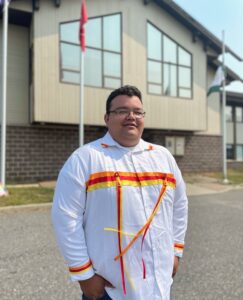Fort William gears up for additional emergency response services

By Rick Garrick
FORT WILLIAM — Fort William fire prevention officer William Solomon is focusing on fire safety education and identification of hazards in the home as the community works to establish its own fire department.
“The first line of defence in fire safety is knowledge,” says Solomon, a graduate of Confederation College’s Pre-Service Firefighter Education and Training Program. “That’s what I’ve been instilling until we get our fire department up and running — I started off with our Elders because some of them don’t have people in their lives that can help them make sure their homes are safe.”
Solomon says the community has already received two fire trucks, a pumper and a tanker, from Firefighters Without Borders.
“Once we get our funding sources approved, we will have a building up — that’s where we can start training our [citizens],” Solomon says. “Once we have our [citizens] trained, that’s when we will start responding to emergencies in the community.”
Solomon says the firefighters would be able to provide a rapid response to any fires in the community. Thunder Bay Fire Rescue currently provides fire protection and emergency services in the community.
“We would make sure we get our feet on the ground at the fire as soon as possible,” Solomon says. “And we would still have Thunder Bay Fire come in and supply extra resources. In the future, we would like to be the sole responders to these fires and then if need be, we would have an automatic aid agreement with Thunder Bay Fire and neighbouring municipalities to come in and give us a hand, and it goes the same way the other way; if they needed us, we would be there to lend them any resources that we have.”
Solomon says he has been working on getting new smoke alarms installed in homes in the community, teaching residents about testing the smoke alarms on a regular basis and providing information on the importance of having working fire extinguishers and home escape plans.
“Identifying hazards in the home was a very big thing, too,” Solomon says. “Some of our Elders have their windows nailed shut, they have couches and cabinets blocking other exits, so we’ve been focusing on fire prevention and making sure the community has the knowledge they need to identify these hazards and problems and fix them as quickly as possible.”
Ontario Regional Chief Glen Hare and Nishnawbe Aski Nation Grand Chief Alvin Fiddler identified key priorities for major improvements to fire safety and prevention following the July release of the Ontario Chief Coroner’s Table on Understanding Fire Deaths in First Nations (OCC-TUFDFN) Report. The OCC-TUFDFN identified 56 deaths in 29 fires that occurred in 20 First Nations across Ontario from 2008-2017.
“This report does not come as a surprise — it has highlighted the critical need for First Nations to have access to adequate housing, fire safety education, and fire protection services and equipment in order to keep community members safe,” Regional Chief Hare says. “First Nations leadership has worked tirelessly for the protection of their communities, and we must address systemic issues that contribute to the ongoing fire-related deaths, including inadequate housing and infrastructure and outdated fire safety and suppression equipment. These fatal fires can be prevented, and it is not the only reason why First Nations are in need of improvements in housing, infrastructure and water.”
The OCC-TUFDFN found that First Nations children under 10-years-old had the highest fire-related mortality rate, which was 86 times greater than non-First Nations children in Ontario.
The OCC-TUFDFN report is available online.


